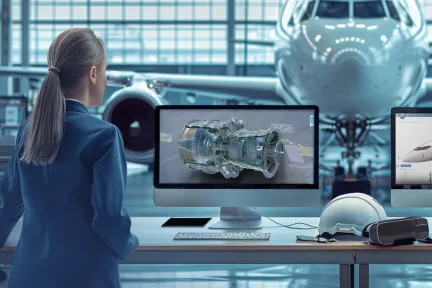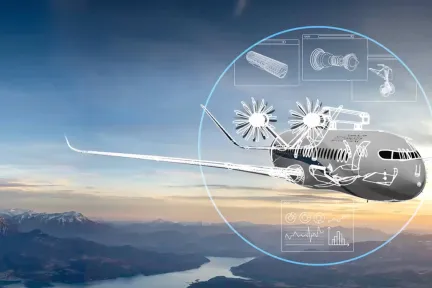Drive Costs Down
Accelerate program maturity from concept to manufacturing while driving out 40 to 60% of costs.
Drive Cost Out
Learn how using a model-based enterprise approach can help deliver programs and projects on-time and on-budget.
Drive Out Cost Despite Growing Complexity of Systems
In the aerospace industry, companies face mounting pressure to innovate rapidly while maintaining tight control over costs. As global competition intensifies and passenger expectations evolve, the need to develop more advanced, efficient and cost-effective aircraft becomes critical. The ability to reduce costs by 40-60% can be a significant competitive advantage, enabling companies to stay ahead of more agile competitors. Achieving this requires not only integrating new technologies into increasingly complex systems but also rethinking traditional processes from concept to manufacturing. This transformation is essential to meet both operator cost and uptime targets, as well as to ensure the long-term viability of aerospace programs.
Challenges in Aerospace: Complexity and Cost Pressure
Aerospace companies today are grappling with the dual challenge of growing system complexity and intense cost pressures. The integration of cutting-edge technologies—such as advanced materials, avionics and propulsion systems—into new aircraft designs adds layers of complexity that must be managed effectively. Additionally, there is a continuous need to meet passengers’ demand for better in-flight experiences, while also addressing the operational requirements of airlines, such as fuel efficiency, reduced maintenance costs, and enhanced safety features.
This complexity is compounded by the global nature of the aerospace supply chain, where collaboration across different functions, organizations and geographical locations is crucial. Without effective coordination, projects can suffer from delays, cost overruns and quality issues, which ultimately impact the bottom line. To navigate these challenges, aerospace companies must adopt innovative approaches that allow them to conceptualize, design, manufacture and support aircraft more efficiently.
Discover How Dassault Systèmes Drives Cost Down
We introduced harmony in our processes, methods and tools, saving precious time that we instead spent on innovation.
Strategies to Drive Down Costs
By leveraging a full-system digital mockup, aerospace companies can create a unified, integrated model that serves as the single source of truth for all teams involved in the project. This model allows different functions—such as design, engineering, and manufacturing—to work concurrently, rather than sequentially. This concurrent engineering approach not only accelerates the development process but also ensures that all stakeholders are aligned, reducing the likelihood of costly errors and rework. With a shared, up-to-date model, teams can collaborate more effectively, making informed decisions that drive efficiency and cost savings throughout the project.
Effective project management is essential to keeping aerospace programs on track and within budget. By continuously monitoring critical project metrics—such as schedule adherence, budget consumption, resource allocation, and deliverables—companies can proactively address potential issues before they escalate. Real-time data and analytics provide insights into the current status of the project, enabling teams to make adjustments as needed to stay on course. This level of oversight helps to ensure that the program remains aligned with its objectives, minimizing the risk of delays, cost overruns, and supply chain disruptions.
Aerospace projects are complex and often involve stringent contractual obligations. Maintaining strong program control is key to ensuring that these projects are delivered on time, within budget, and according to specification. This involves rigorous oversight of the project’s progress, including tracking milestones, managing risks, and ensuring compliance with regulatory requirements. By staying vigilant and maintaining clear communication with all stakeholders, companies can avoid contract penalties and other financial setbacks that can arise from missed deadlines or unmet specifications. Strong program control also enables better resource management, ensuring that all aspects of the project are optimized for efficiency and cost-effectiveness.
Design optimization is a critical factor in reducing costs in aerospace programs. By refining the design of components, subsystems, and systems, companies can eliminate inefficiencies and reduce material and production costs. This process involves using advanced simulation tools and analytical methods to evaluate different design alternatives, identify the most cost-effective solutions, and ensure that these designs integrate seamlessly into the overall system. Proper integration is essential to avoid compatibility issues that can lead to costly modifications or delays. By focusing on design optimization and integration, aerospace companies can enhance the performance and reliability of their products while driving down costs.
Transforming aerospace programs to drive out cost:
Work concurrently in context of a full system digital mockup providing a single version of the truth.
Continuously monitor schedule, budget, resource allocation and deliverables across the supply chain.
Maintain strong program control to stay on time, on cost and on spec while avoiding contract penalties.
Optimize the design of components, subsystems and systems while ensuring proper integration to drive out costs.
The Role of the 3DEXPERIENCE® Platform
The 3DEXPERIENCE platform from Dassault Systèmes plays a pivotal role in enabling aerospace companies to achieve these cost-saving objectives. Going beyond the traditional digital mockup (DMU), the platform introduces the concept of a System Digital Mockup (S-DMU). This innovative approach provides a comprehensive, unified view of the entire system, from individual components to the complete aircraft.
By offering a common reference across all phases of development, the 3DEXPERIENCE platform facilitates seamless collaboration between teams and organizations. Engineers, designers, and manufacturers can work together more effectively, sharing data and insights that help to optimize design efforts and reduce rework. This level of integration is critical for managing the complexity of modern aerospace programs and ensuring that they are delivered on schedule, on cost, and to the highest standards.
Moreover, the platform supports continuous improvement by enabling real-time monitoring of project metrics, such as schedule adherence, budget consumption, and resource allocation. With these capabilities, companies can proactively address potential issues before they escalate, minimizing the risk of delays or cost overruns. The result is a more efficient and streamlined development process that drives down costs by up to 60%, allowing aerospace companies to remain competitive in a rapidly evolving market.
Cost Reduction in Aerospace & Defense (FAQ)
Discover Our Customer Stories
Explore Our Industry Solution Experiences
Accelerate program integration while eliminating costs:



